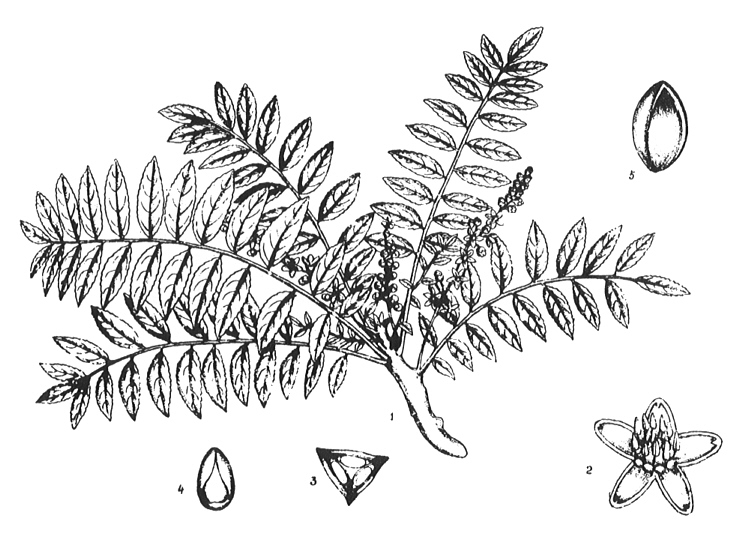

Zitierweise / cite as:
Carakasaṃhitā: Ausgewählte Texte aus der Carakasaṃhitā / übersetzt und erläutert von Alois Payer <1944 - >. -- Anhang A: Pflanzenbeschreibungen. -- Boswellia serrata Roxb. -- Fassung vom 2007-06-27. -- URL: http://www.payer.de/ayurveda/pflanzen/boswellia_serrata.htm
Erstmals publiziert: 2007-06-27
Überarbeitungen:
Anlass: Lehrveranstaltung SS 2007
©opyright: Dieser Text steht der Allgemeinheit zur Verfügung. Eine Verwertung in Publikationen, die über übliche Zitate hinausgeht, bedarf der ausdrücklichen Genehmigung des Verfassers
Dieser Text ist Teil der Abteilung Sanskrit von Tüpfli's Global Village Library
WARNUNG: dies ist der Versuch einer
Übersetzung und Interpretation eines altindischen Textes. Es ist keine
medizinische Anleitung. Vor dem Gebrauch aller hier genannten Heilmittel wird
darum ausdrücklich gewarnt. Nur ein erfahrener, gut ausgebildeter ayurvedischer
Arzt kann Verschreibungen und Behandlungen machen!
Falls Sie die diakritischen Zeichen nicht dargestellt bekommen, installieren Sie eine Schrift mit Diakritika wie z.B. Tahoma.
Verwendete und zitierte Werke siehe: http://www.payer.de/ayurveda/caraka0001.htm
śallakī — Boswellia serrata Roxb. ex Colebr. — Indischer Weihrauch

Abb.: Boswellia serrata Roxb.
[Bildquelle: Kirtikar-Basu, ©1918]
Drury:
"Boswellia glabra (Roxb.) N. O. Terebinthaceae.
- Koonthrekum. Mal.
- Googoola Tel.
- Koondicrum, Tam.
Description.—Tall erect tree covered with greenish ash-coloured bark; leaves alternate, unequally pinnate, at the extremities of the branchlets; leaflets 6-10 pairs, opposite, broadly lanceolate, obtuse, serrated, glabrous; flowers numerous, on short pedicels, small, white; calyx small, 5-toothed ; petals 5; capsule -3-angled, 3-celled, 3-valved; seeds solitary, surrounded by a membranaceous wing; racemes simple, terminal, fascicled, shorter than the leaves. Fl. March—April. --- W. & A. Prod. I 174—Roxb. Flor. Ind. ii 384.—Cor. iii. t. 207.-------Coromandel mountains. Deccan.
Medical Uses.—This tree yields a fragrant resinous substance known as Koondricum. It is bitter and pungent, and is soluble in ether and spirits of wine. Resin exudes from wounds in the bark. It soon becomes bard and brittle, and is often used, when boiled with oil, as a substitute for pitch, and called Googul by the Telingies. Mixed with ghee, the native doctors prescribe it in gonorrhoea and other complaints. The resin is much burnt as an incense in the religious ceremonies of the Hindoos. Mixed with lime-juice or cocoa-nut oil, it is applied at a plaster in cutaneous affections, as well as in cases of ulcers and bad wounds.—(Ainslie. Roxb.) The resin both of this and the following species is employed as an incense in India, and both might be much more extensively collected than they are at present, as there is reason to believe that Central India alone furnishes the greatest portion of the Indian olibanum of commerce, as it is chiefly exported from Bombay.—(Royle.) There are extensive tracts of Googalam jungles in Goomsur and Cuttack provinces. The Khoonds and Woodias living in or near these jungles wound the trees in several places. The resin flows out, and is collected when sufficiently solid. The dammer collected from the decayed parts of the tree is of a dark colour. The Khoonds and Uryas make the leaves into the plates from off which they eat their food, and also roll up tobacco in them to smoke like a cheroot. In times of famine the above tribes live on a soup made from the fruit of the tree.—Rep. Mad. Exhib."
[Quelle: Drury, Heber <1819 - 1872>: The useful plants of India : with notices of their chief value in commerce, medicine, and the arts. -- 2d ed. with additions and corrections. London : Allen, 1873. -- xvi, 512 p. ; 22 cm. -- s.v.]
Köhler:
Boswellia thurifera Colebr. (B. glabra Roxb., B. serrata Stachh., Salai oder Salphal der Indier) tritt in dem mittleren nnd nördlichen Teile Ostindiens auf, gibt ein terpentinartiges, nach Weihrauch riechendes Harz, welches erst nach Jahresfrist erhärtet und in Indien die Stelle des Weihrauchs vertritt. Es gelangt nicht zur Ausfuhr und ist nach der Flückiger'schen Angabe in Bombay ganz unbekannt. Nees v. Esenb. Plant med. Taf. 355; Hayne, Arzneigew. X, Taf. 16; Berg und Schmidt, Offiz. Gew., Taf. XIVc." [Quelle: Köhler's Medizinal-Pflanzen in naturgetreuen Abbildungen mit kurz erläuterndem Texte : Atlas zur Pharmacopoea germanica, austriaca, belgica, danica, helvetica, hungarica, rossica, suecica, Neerlandica, British pharmacopoeia, zum Codex medicamentarius, sowie zur Pharmacopoeia of the United States of America / hrsg. von G. Pabst. -- Gera-Untermhaus : Köhler, 1887-1898. -- 3 Bde.]